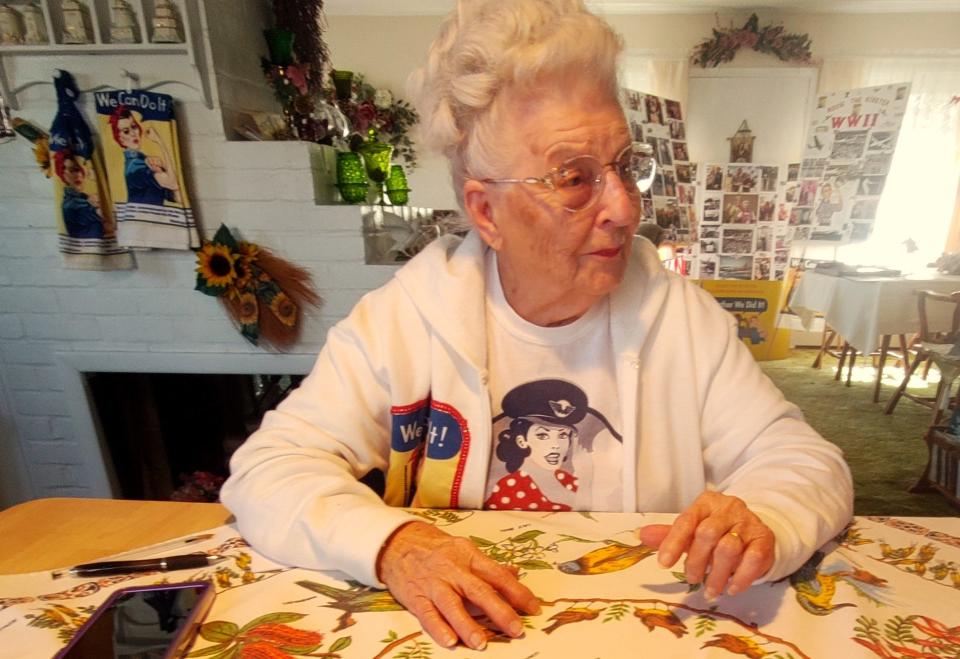Bucks County's Rosie the Riveter: Mae Krier receives Congressional medal of honor April 10
Mae Krier’s social calendar makes a 9 to 5 job look like a lark.
She’s been to the Pentagon several times “where I hugged a general.” She drove a tank in San Antonio. She’s made her mark on the space station orbiting the earth. In Uvalde, Texas, after the school mass shooting, she lifted spirits and holds a key to the city.
On April 10, she’ll be standing before Congress to receive the nation’s highest honor. In June, she’ll make her third trip to France as honored guest. On July 4 she’ll be back in D.C. for more accolades. That’s not to mention parades and countless TV and radio interviews from coast to coast.
Wednesday, April 10, she will be in Washington, D.C. to receive the congressional medal of honor. For years, she helped lead the effort to have the medal awarded to the nation's "Rosie the Riveters" for their contributions during World War II.
More: Levittown 'Rosie the Riveter:' Mission accomplished with Trump signature on medal honor
Who is this remarkable Bucks County woman in her late 90s?

Mae is a World War II icon. She built bombers as a teenager. Lots of them.
Recently she invited me and my pal Wynne Wert to her comfortable Levittown home where she told her story with sparkling wit and energy that belies her 98 years. I wondered aloud what people are called in their 90s when those in their 80s are “octogenarians.”
In a flash she replied with a twinkle, “Cliffhangers!” Ha!
Mae was among millions of women in the 1940s who smashed through the glass ceiling in male-dominated defense industries. Today they’re known as “Rosie the Riveters.”
The transformation of “Mae the Riveter” began right out of high school in Dawson, North Dakota. The country was desperate for help building tanks, planes, artillery, bullets and much more to fortify America and its allies. Men of fighting age were drafted, draining factories of needed labor.
The War Department in Washington recruited about 5 million women to fill the vacancies in war factories.
A popular 1943 tune by the Four Vagabonds gave them a nickname — “Rosie the Riveter.” Idealized posters by artists J. Howard Miller (“We Can Do It”) and Norman Rockwell (“Rosie”) made her famous. In this environment, Mae was just 17.
In the summer of 1943, she and her sister moved into a friend’s home in Seattle to get jobs at the nearby Boeing Aircraft plant. Mae became skilled as an assembly line riveter building wings and engine housings for B-17 and B-29 bombers.
“I was like a tomboy growing up. At Boeing, I just dug in. I loved to work, and I was good at it.” The primarily female workforce was quite able. “We had more agile hands than the men and were more organized.”
The factory was a noisy place. “When we would come home at night, we tended to shout to each other until our friend’s father would say, ‘Will you girls pipe down?’”
Mae is particularly proud of her work on B-17 “Flying Fortress” bombers. The 5,000th rolled out in 1944. Mae and coworkers painted their names all over it. “Five Grand” successfully completed 78 bombing missions over Europe, signatures intact.
“Part of me went with the plane,” Mae reflected. “I followed it all the way through, ’til it was scrapped.” Ultimately, the Rosie workforce in the U.S. produced 300,000 planes, 100,000 tanks, 88,000 warships, 47 tons of artillery shells and 44 billion rounds of ammunition.
During the war, Mae married a sailor she met at an armed forces dance. “I worked all day and danced all night. I don’t know how I did it,” she laughed. Norm Krier was “cute” and an accomplished dancer who grew up in Morrisville. When the war ended and veterans returned to victory parades and their factory jobs, the Rosies were let go.
The Navy transferred Norm to a new base where Mae got a job alongside Italian POWs packing materials for overseas shipment. The couple eventually moved to Morrisville where they started a family. Mae secured a riveting job at the Kaiser aircraft factory in Bristol. Through the decades, “Rosie” memories faded in America. Then a single moment changed everything.
Next Friday: Mae’s epiphany.
Sources include “Riveting tales of World War II” by Bucks County Courier Times staff writer Gwen Shrift published on Dec. 14, 2014, and “Mae Krier: I just never quit” by Tess Harmon published in Austin (Texas) Woman Magazine on May 23, 2023.
Carl LaVO can be reached at carllavo0@gmail.com
This article originally appeared on Bucks County Courier Times: Levittown's Rosie the Riveter to go to Washington to receive congressional medal

